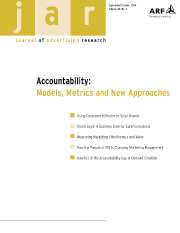Crossref Citations
This article has been cited by the following publications. This list is generated based on data provided by
Crossref.
Moorthi, Y.L.R.M.
2002.
Branding Principles - Application to Business-to-Business Branding.
SSRN Electronic Journal,
Funk, Daniel C.
2002.
Consumer-Based Marketing: The Use of Micro-Segmentation Strategies for Understanding Sport Consumption.
International Journal of Sports Marketing and Sponsorship,
Vol. 4,
Issue. 3,
p.
39.
Murase, Hanako
and
Bojanic, David
2004.
An Examination of the Differences in Restaurant Brand Personality Across Cultures.
Journal of Hospitality & Leisure Marketing,
Vol. 11,
Issue. 2-3,
p.
97.
2006.
Markenstärkemessung unter besonderer Berücksichtigung von Konsumentenheterogenität.
p.
289.
Chau, Patrick Y. K.
and
Ho, Candy K. Y.
2008.
Developing Consumer-Based Service Brand Equity via the Internet: The Role of Personalization and Trialability.
Journal of Organizational Computing and Electronic Commerce,
Vol. 18,
Issue. 3,
p.
197.
Tasci, Asli D. A.
and
Denizci, Basak
2009.
Destination Branding Input–Output Analysis: A Method of Evaluating Productivity.
Tourism Analysis,
Vol. 14,
Issue. 1,
p.
65.
Boo, Soyoung
Busser, James
and
Baloglu, Seyhmus
2009.
A model of customer-based brand equity and its application to multiple destinations.
Tourism Management,
Vol. 30,
Issue. 2,
p.
219.
Boo, Soyoung
2010.
Destination Brand Attitude and Loyalty as Factors in Revisitation of Competitive Destinations.
Tourism Review International,
Vol. 14,
Issue. 4,
p.
163.
Vieceli, Julian
and
Shaw, Robin N.
2010.
Brand salience for fast-moving consumer goods: An empirically based model.
Journal of Marketing Management,
Vol. 26,
Issue. 13-14,
p.
1218.
Chen, Po‐Tsang
and
Hu, Hsin‐Hui
2010.
How determinant attributes of service quality influence customer‐perceived value.
International Journal of Contemporary Hospitality Management,
Vol. 22,
Issue. 4,
p.
535.
Bruhn, Manfred
and
Georgi, Dominik
2010.
Marktorientiertes Sportmanagement: Empirische Analyse des Einflusses der Marketinginstrumente auf die Markenstärke eines Sportevents.
Zeitschrift für Management,
Vol. 5,
Issue. 4,
p.
333.
Salvador, Elisa
2011.
Are science parks and incubators good “brand names” for spin-offs? The case study of Turin.
The Journal of Technology Transfer,
Vol. 36,
Issue. 2,
p.
203.
Wonjin Jung
2012.
The Effects of Perceived Values of Mobile Shopping on Customer Loyalty and Purchase Intention.
The e-Business Studies,
Vol. 13,
Issue. 5,
p.
203.
Guzmán, Francisco
Cuneo, Andres
Lopez, Pilar
and
Jesus Yague, Maria
2012.
Private label brands: measuring equity across consumer segments.
Journal of Product & Brand Management,
Vol. 21,
Issue. 6,
p.
428.
Ha, Jane
and
Hwang, Jin-Sook
2014.
The Impact of Korean Country Image on Brand Identity, Brand Attitude and Purchase Intention -A Case for Chinese Consumers-.
Journal of the Korean Society of Clothing and Textiles,
Vol. 38,
Issue. 2,
p.
251.
Dass, Mayukh
Kohli, Chiranjeev
Kumar, Piyush
and
Thomas, Sunil
2014.
A study of the antecedents of slogan liking.
Journal of Business Research,
Vol. 67,
Issue. 12,
p.
2504.
Ali, Alisha
and
Sharma, Vishal
2014.
Can brand personality differentiate fast food restaurants?.
Research in Hospitality Management,
Vol. 4,
Issue. 1-2,
p.
13.
Schwaiger, Manfred
and
Raithel, Sascha
2014.
Reputation und Unternehmenserfolg.
Management Review Quarterly,
Vol. 64,
Issue. 4,
p.
225.
Florek, Magdalena
2015.
Rethinking Place Branding.
p.
225.
Huang, Zhuowei (Joy)
and
Cai, Liping A.
2015.
Modeling consumer-based brand equity for multinational hotel brands – When hosts become guests.
Tourism Management,
Vol. 46,
Issue. ,
p.
431.


